Comparative Assessment of Cross River Rail and Brisbane Metro
VerifiedAdded on 2023/06/03
|25
|7741
|400
Report
AI Summary
This report presents a comprehensive analysis of the Cross River Rail project, a major infrastructure initiative in South East Queensland (SEQ), and provides a comparative assessment with the Brisbane Metro project. The analysis delves into various aspects of the Cross River Rail, including its objectives, values, lifecycle impacts, applicable civil engineering systems, and project stewardship. The report highlights the project's significance in addressing increasing transportation demand and traffic congestion in the SEQ region. The Cross River Rail project, estimated at a cost of $5.4 billion, is designed to alleviate pressure on the existing rail network, spur economic growth, improve social life, and protect the environment through improved air quality and reduced carbon emissions. The report assesses the project's lifecycle, from initial planning and procurement to design, development, delivery, operation, maintenance, and retirement, and the civil engineering systems involved. The report also explores the project's values, including economic, social, sustainability, and political dimensions. A comparative assessment is made with the Brisbane Metro project, emphasizing their complementary roles in enhancing the region's transit network. Informed recommendations and conclusions are provided to support the successful delivery of both projects, highlighting their importance for the sustainable development of the SEQ region.
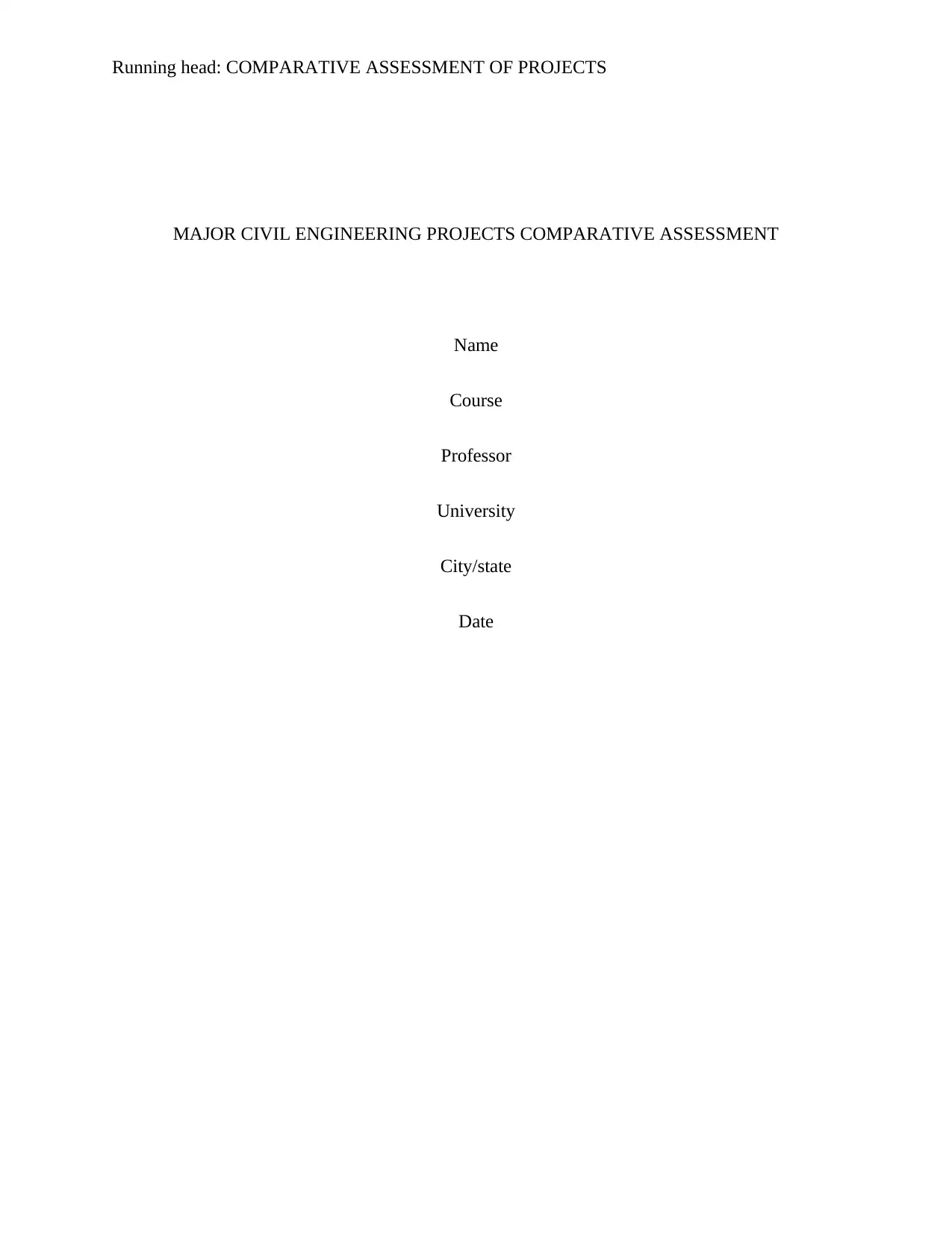
Running head: COMPARATIVE ASSESSMENT OF PROJECTS
MAJOR CIVIL ENGINEERING PROJECTS COMPARATIVE ASSESSMENT
Name
Course
Professor
University
City/state
Date
MAJOR CIVIL ENGINEERING PROJECTS COMPARATIVE ASSESSMENT
Name
Course
Professor
University
City/state
Date
Paraphrase This Document
Need a fresh take? Get an instant paraphrase of this document with our AI Paraphraser
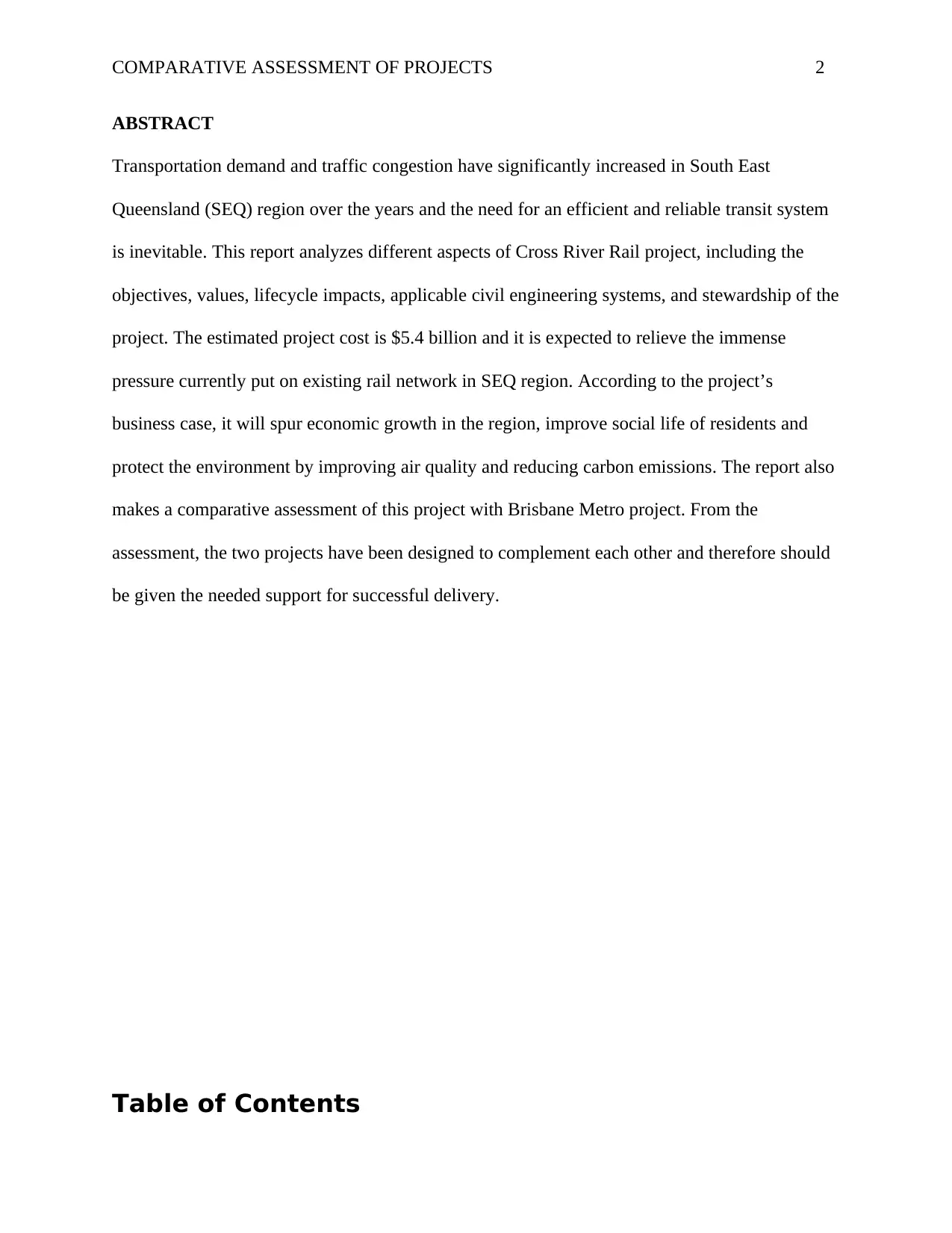
COMPARATIVE ASSESSMENT OF PROJECTS 2
ABSTRACT
Transportation demand and traffic congestion have significantly increased in South East
Queensland (SEQ) region over the years and the need for an efficient and reliable transit system
is inevitable. This report analyzes different aspects of Cross River Rail project, including the
objectives, values, lifecycle impacts, applicable civil engineering systems, and stewardship of the
project. The estimated project cost is $5.4 billion and it is expected to relieve the immense
pressure currently put on existing rail network in SEQ region. According to the project’s
business case, it will spur economic growth in the region, improve social life of residents and
protect the environment by improving air quality and reducing carbon emissions. The report also
makes a comparative assessment of this project with Brisbane Metro project. From the
assessment, the two projects have been designed to complement each other and therefore should
be given the needed support for successful delivery.
Table of Contents
ABSTRACT
Transportation demand and traffic congestion have significantly increased in South East
Queensland (SEQ) region over the years and the need for an efficient and reliable transit system
is inevitable. This report analyzes different aspects of Cross River Rail project, including the
objectives, values, lifecycle impacts, applicable civil engineering systems, and stewardship of the
project. The estimated project cost is $5.4 billion and it is expected to relieve the immense
pressure currently put on existing rail network in SEQ region. According to the project’s
business case, it will spur economic growth in the region, improve social life of residents and
protect the environment by improving air quality and reducing carbon emissions. The report also
makes a comparative assessment of this project with Brisbane Metro project. From the
assessment, the two projects have been designed to complement each other and therefore should
be given the needed support for successful delivery.
Table of Contents

COMPARATIVE ASSESSMENT OF PROJECTS 3
ABSTRACT...............................................................................................................................................2
1. INTRODUCTION.............................................................................................................................3
2. PROJECT NEEDS........................................................................................................................4
3. PROJECT LIFECYCLE..............................................................................................................5
3.1. Initial Planning..........................................................................................................................5
3.2. Procurement...............................................................................................................................6
3.3. Design.........................................................................................................................................7
3.4. Development...............................................................................................................................8
3.5. Delivery.......................................................................................................................................9
3.6. Operation and Maintenance...................................................................................................10
3.7. Retirement................................................................................................................................10
3.8. Research Needs........................................................................................................................11
4. CIVIL ENGINEERING SYSTEM.................................................................................................12
5. PROJECT STEWARDSHIP..........................................................................................................12
6. PROJECT VALUES.......................................................................................................................13
6.1. Economic..................................................................................................................................13
6.2. Social.........................................................................................................................................14
6.3. Sustainability............................................................................................................................15
6.4. Political.....................................................................................................................................16
7. COMPARATIVE ASSESSMENT..................................................................................................16
8. CONCLUSIONS AND INFORMED RECOMMENDATIONS..................................................21
8.1. Conclusions..............................................................................................................................21
8.2. Informed Recommendations...................................................................................................22
Works Cited...............................................................................................................................................24
1. INTRODUCTION
The aim of this paper is to conduct a comprehensive analysis of Cross River Rail and
make a comparative assessment with a similar project in the region – Brisbane Metro. The
ABSTRACT...............................................................................................................................................2
1. INTRODUCTION.............................................................................................................................3
2. PROJECT NEEDS........................................................................................................................4
3. PROJECT LIFECYCLE..............................................................................................................5
3.1. Initial Planning..........................................................................................................................5
3.2. Procurement...............................................................................................................................6
3.3. Design.........................................................................................................................................7
3.4. Development...............................................................................................................................8
3.5. Delivery.......................................................................................................................................9
3.6. Operation and Maintenance...................................................................................................10
3.7. Retirement................................................................................................................................10
3.8. Research Needs........................................................................................................................11
4. CIVIL ENGINEERING SYSTEM.................................................................................................12
5. PROJECT STEWARDSHIP..........................................................................................................12
6. PROJECT VALUES.......................................................................................................................13
6.1. Economic..................................................................................................................................13
6.2. Social.........................................................................................................................................14
6.3. Sustainability............................................................................................................................15
6.4. Political.....................................................................................................................................16
7. COMPARATIVE ASSESSMENT..................................................................................................16
8. CONCLUSIONS AND INFORMED RECOMMENDATIONS..................................................21
8.1. Conclusions..............................................................................................................................21
8.2. Informed Recommendations...................................................................................................22
Works Cited...............................................................................................................................................24
1. INTRODUCTION
The aim of this paper is to conduct a comprehensive analysis of Cross River Rail and
make a comparative assessment with a similar project in the region – Brisbane Metro. The
⊘ This is a preview!⊘
Do you want full access?
Subscribe today to unlock all pages.

Trusted by 1+ million students worldwide
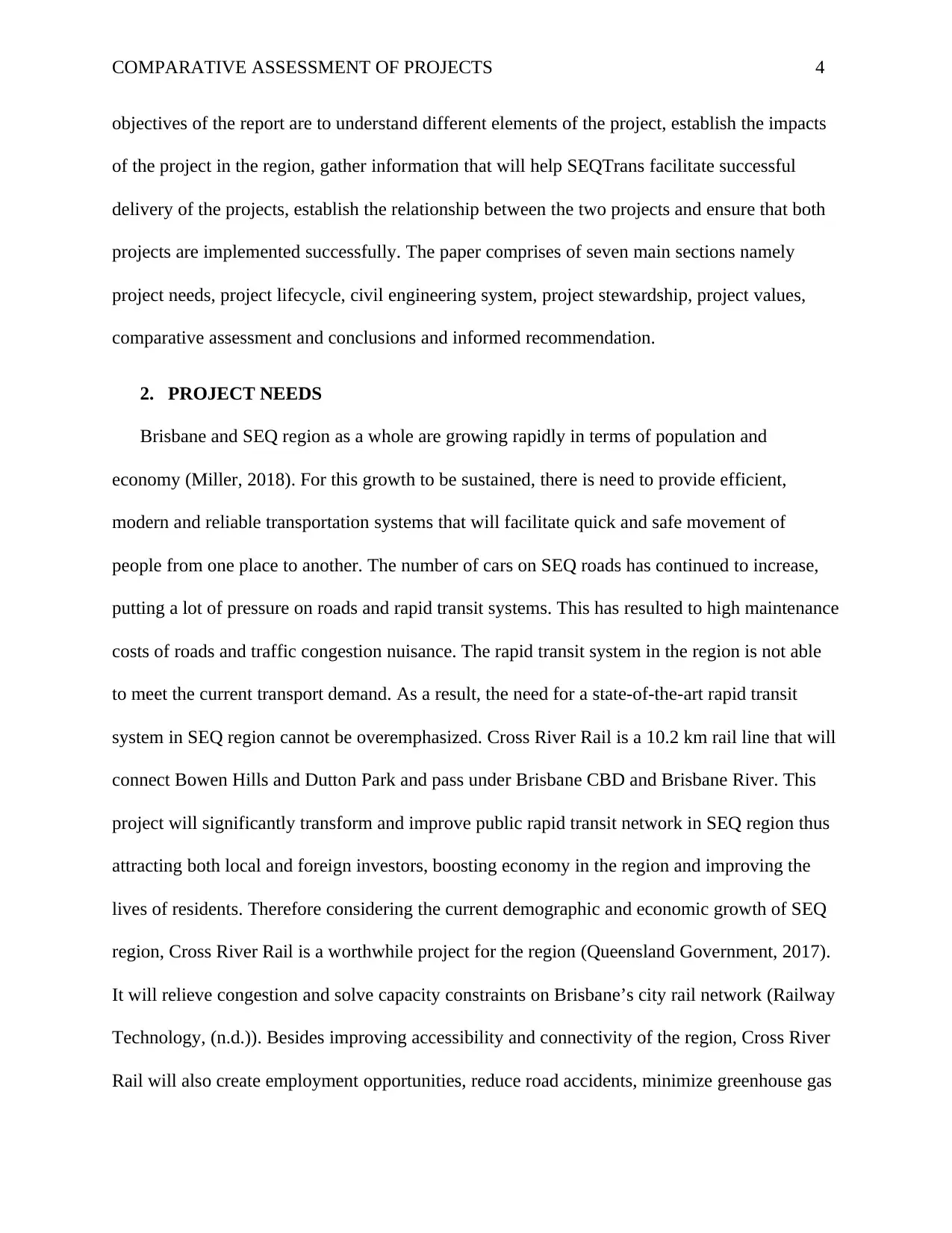
COMPARATIVE ASSESSMENT OF PROJECTS 4
objectives of the report are to understand different elements of the project, establish the impacts
of the project in the region, gather information that will help SEQTrans facilitate successful
delivery of the projects, establish the relationship between the two projects and ensure that both
projects are implemented successfully. The paper comprises of seven main sections namely
project needs, project lifecycle, civil engineering system, project stewardship, project values,
comparative assessment and conclusions and informed recommendation.
2. PROJECT NEEDS
Brisbane and SEQ region as a whole are growing rapidly in terms of population and
economy (Miller, 2018). For this growth to be sustained, there is need to provide efficient,
modern and reliable transportation systems that will facilitate quick and safe movement of
people from one place to another. The number of cars on SEQ roads has continued to increase,
putting a lot of pressure on roads and rapid transit systems. This has resulted to high maintenance
costs of roads and traffic congestion nuisance. The rapid transit system in the region is not able
to meet the current transport demand. As a result, the need for a state-of-the-art rapid transit
system in SEQ region cannot be overemphasized. Cross River Rail is a 10.2 km rail line that will
connect Bowen Hills and Dutton Park and pass under Brisbane CBD and Brisbane River. This
project will significantly transform and improve public rapid transit network in SEQ region thus
attracting both local and foreign investors, boosting economy in the region and improving the
lives of residents. Therefore considering the current demographic and economic growth of SEQ
region, Cross River Rail is a worthwhile project for the region (Queensland Government, 2017).
It will relieve congestion and solve capacity constraints on Brisbane’s city rail network (Railway
Technology, (n.d.)). Besides improving accessibility and connectivity of the region, Cross River
Rail will also create employment opportunities, reduce road accidents, minimize greenhouse gas
objectives of the report are to understand different elements of the project, establish the impacts
of the project in the region, gather information that will help SEQTrans facilitate successful
delivery of the projects, establish the relationship between the two projects and ensure that both
projects are implemented successfully. The paper comprises of seven main sections namely
project needs, project lifecycle, civil engineering system, project stewardship, project values,
comparative assessment and conclusions and informed recommendation.
2. PROJECT NEEDS
Brisbane and SEQ region as a whole are growing rapidly in terms of population and
economy (Miller, 2018). For this growth to be sustained, there is need to provide efficient,
modern and reliable transportation systems that will facilitate quick and safe movement of
people from one place to another. The number of cars on SEQ roads has continued to increase,
putting a lot of pressure on roads and rapid transit systems. This has resulted to high maintenance
costs of roads and traffic congestion nuisance. The rapid transit system in the region is not able
to meet the current transport demand. As a result, the need for a state-of-the-art rapid transit
system in SEQ region cannot be overemphasized. Cross River Rail is a 10.2 km rail line that will
connect Bowen Hills and Dutton Park and pass under Brisbane CBD and Brisbane River. This
project will significantly transform and improve public rapid transit network in SEQ region thus
attracting both local and foreign investors, boosting economy in the region and improving the
lives of residents. Therefore considering the current demographic and economic growth of SEQ
region, Cross River Rail is a worthwhile project for the region (Queensland Government, 2017).
It will relieve congestion and solve capacity constraints on Brisbane’s city rail network (Railway
Technology, (n.d.)). Besides improving accessibility and connectivity of the region, Cross River
Rail will also create employment opportunities, reduce road accidents, minimize greenhouse gas
Paraphrase This Document
Need a fresh take? Get an instant paraphrase of this document with our AI Paraphraser

COMPARATIVE ASSESSMENT OF PROJECTS 5
emissions and make the region more competitive and sustainable. The network of Cross River
Rail is as shown in Figure 1 below.
Figure 1: Cross River Rail network
3. PROJECT LIFECYCLE
3.1. Initial Planning
The original proposal of Cross River Rail was released in November 2010 by Queensland
Government. It comprised of a 9.8 km tunnel, four underground stations and two surface
stations. This proposal was developed following a report released in 2008 which showed that
peak train services demand in Brisbane would double by 2016. This proposal was changed in
June 2012 after Newman Government took power. The new government revised the plan to
reduce its capital cost by excluding modernizations to existing stations. The new proposal was
emissions and make the region more competitive and sustainable. The network of Cross River
Rail is as shown in Figure 1 below.
Figure 1: Cross River Rail network
3. PROJECT LIFECYCLE
3.1. Initial Planning
The original proposal of Cross River Rail was released in November 2010 by Queensland
Government. It comprised of a 9.8 km tunnel, four underground stations and two surface
stations. This proposal was developed following a report released in 2008 which showed that
peak train services demand in Brisbane would double by 2016. This proposal was changed in
June 2012 after Newman Government took power. The new government revised the plan to
reduce its capital cost by excluding modernizations to existing stations. The new proposal was

COMPARATIVE ASSESSMENT OF PROJECTS 6
again revised by the Queensland Government in November 2013 and came up with Bus and
Train (BaT) Tunnel proposal. The proposal was a 5.4 km tunnel with an external diameter of
14.8 m. The tunnel would accommodate two lane busway at the top and a dual rail truck on the
bottom of the tunnel. Construction of the project was planned to start in 2015 and be completed
in 2021 at a cost of $5 billion. The BaT Tunnel proposal was replaced with the Cross River Rail
in 2016. The Queensland Government released the business case of Cross River Rail in August
2017 and work officially began in September 2017. The planning of Cross River Rail was led by
Queensland Government agency, Cross River Rail Delivery Authority, through collaboration
with urban planners, traffic engineers, management professionals, structural engineers,
architects, electrical engineers, mechanical engineers, surveyors, and other government agencies
such as departments of infrastructure, transport and regional development; regional services;
environment; and trade tourism and investment. The project also resonates other policies such as
Shaping SEQ Regional Plan 2017, State Infrastructure Plan; Australian Infrastructure Plan,
Smart Cities Plan, and Brisbane City Centre Master Plan 2014, among others. Some of the key
elements during planning process of the project include: design elements, social, economic and
environmental impacts, resource efficiency, community consultation and engagement, source of
funding, project constraints, cost benefit ratio, and regulatory standards and approvals.
3.2. Procurement
Cross River Rail Delivery Authority is responsible for procurement of Cross River Rail
project. The procurement was anticipated to commence in third quarter of 2017 and end in first
quarter of 2019. The procurement is to be done in accordance with Project Assessment
Framework of Queensland Government and Queensland Procurement Policy. The main
objectives of procurement for this project are to encourage private sector innovation and
again revised by the Queensland Government in November 2013 and came up with Bus and
Train (BaT) Tunnel proposal. The proposal was a 5.4 km tunnel with an external diameter of
14.8 m. The tunnel would accommodate two lane busway at the top and a dual rail truck on the
bottom of the tunnel. Construction of the project was planned to start in 2015 and be completed
in 2021 at a cost of $5 billion. The BaT Tunnel proposal was replaced with the Cross River Rail
in 2016. The Queensland Government released the business case of Cross River Rail in August
2017 and work officially began in September 2017. The planning of Cross River Rail was led by
Queensland Government agency, Cross River Rail Delivery Authority, through collaboration
with urban planners, traffic engineers, management professionals, structural engineers,
architects, electrical engineers, mechanical engineers, surveyors, and other government agencies
such as departments of infrastructure, transport and regional development; regional services;
environment; and trade tourism and investment. The project also resonates other policies such as
Shaping SEQ Regional Plan 2017, State Infrastructure Plan; Australian Infrastructure Plan,
Smart Cities Plan, and Brisbane City Centre Master Plan 2014, among others. Some of the key
elements during planning process of the project include: design elements, social, economic and
environmental impacts, resource efficiency, community consultation and engagement, source of
funding, project constraints, cost benefit ratio, and regulatory standards and approvals.
3.2. Procurement
Cross River Rail Delivery Authority is responsible for procurement of Cross River Rail
project. The procurement was anticipated to commence in third quarter of 2017 and end in first
quarter of 2019. The procurement is to be done in accordance with Project Assessment
Framework of Queensland Government and Queensland Procurement Policy. The main
objectives of procurement for this project are to encourage private sector innovation and
⊘ This is a preview!⊘
Do you want full access?
Subscribe today to unlock all pages.

Trusted by 1+ million students worldwide

COMPARATIVE ASSESSMENT OF PROJECTS 7
participation, achieve the greatest value for money invested, encourage competition, deliver the
project within planned budget and timeframe, and ensure transparency and equity. The key
procurement stages include: appointment of specialists advisers, invite expression of interest and
evaluate them, prepare request for proposal, conduct interactive bidder workshops, develop bid
strategy, select best bidders, conduct negotiations, facilitate necessary government approvals,
conclude on contractual close and develop a suitable contract management strategy. Professional
disciplines involved in the procurement process of the project include: commercial and financial
advisors, legal advisors, environmental impact assessment professionals, engineers
(geotechnical, civil, structural, electrical, and mechanical engineers, and traffic engineers) and
urban planners together with other relevant public and private sector agencies. The required
resources for procurement is funding.
3.3. Design
The key design elements of Cross River Rail are: rail track design, tunnel design, surface and
underground station building architecture and design, landscape architecture, intersection and
connection design, intelligent transport systems design, and automated traffic control systems
design. Some of the professionals involved in key design elements include: geotechnical
engineers, landscape architects, urban planners, rail track designers, water engineers, transport
engineers, structural engineers, environmental engineers, electrical engineers, mechanical
engineers and building architects. Design of these elements also require specialized tools
including: geotechnical modelling software, rail track alignment design software, transport
modelling software, intersection design/analysis software, structural modelling software,
computer aided design (CAD) software (such as AnyRail, OpenRail, Ferrovia, RailModeller,
etc.), and simulation & visualization tools, among others. There are also several design
participation, achieve the greatest value for money invested, encourage competition, deliver the
project within planned budget and timeframe, and ensure transparency and equity. The key
procurement stages include: appointment of specialists advisers, invite expression of interest and
evaluate them, prepare request for proposal, conduct interactive bidder workshops, develop bid
strategy, select best bidders, conduct negotiations, facilitate necessary government approvals,
conclude on contractual close and develop a suitable contract management strategy. Professional
disciplines involved in the procurement process of the project include: commercial and financial
advisors, legal advisors, environmental impact assessment professionals, engineers
(geotechnical, civil, structural, electrical, and mechanical engineers, and traffic engineers) and
urban planners together with other relevant public and private sector agencies. The required
resources for procurement is funding.
3.3. Design
The key design elements of Cross River Rail are: rail track design, tunnel design, surface and
underground station building architecture and design, landscape architecture, intersection and
connection design, intelligent transport systems design, and automated traffic control systems
design. Some of the professionals involved in key design elements include: geotechnical
engineers, landscape architects, urban planners, rail track designers, water engineers, transport
engineers, structural engineers, environmental engineers, electrical engineers, mechanical
engineers and building architects. Design of these elements also require specialized tools
including: geotechnical modelling software, rail track alignment design software, transport
modelling software, intersection design/analysis software, structural modelling software,
computer aided design (CAD) software (such as AnyRail, OpenRail, Ferrovia, RailModeller,
etc.), and simulation & visualization tools, among others. There are also several design
Paraphrase This Document
Need a fresh take? Get an instant paraphrase of this document with our AI Paraphraser

COMPARATIVE ASSESSMENT OF PROJECTS 8
instruments needed for Cross River Rail project. Most of these instruments are those developed
by the Rail Industry Safety and Standards Board and Australian Rail Track Corporation. They
include Australian standards, guidelines, codes of practice and rules. Some of these are: Rail
Safety Act (2010), Environmental Protection Act and Regulations, Railway Infrastructure,
Australian Rapid Transit Assessment Guidelines (ARTAG) and Guide to Traffic Engineering
Practice.
3.4. Development
The key development stages of Cross River Rail are: demolition works, excavation, materials
preparation, surveying, laying the bottom ballast of the rail track, construction of drainage
system of subgrade, installation of anchorage, laying the rail, laying ballast on top of the rail,
installation of rail brace and rail anchor, construction of underground and surface stations,
installation of related mechanical and electrical systems, installation of traffic control and
signaling systems, installation of ticketing systems, and installation of other automated systems
to facilitate operation of the rail network. The main agency responsible for the development of
Cross River Rail is Cross River Rail Delivery Authority. The Authority will work with several
other stakeholders, including federal, state and local government agencies, and professionals to
ensure successful development of the project. Some of the professional disciplines that will be
involved in the development stage of the project include: civil engineering, mechanical
engineering, electrical engineering, quantity surveying, geotechnical engineering, materials
engineering, control systems engineering, GIS engineering, urban planning, environmental
engineering, traffic engineering, architecture, construction engineering, etc. The development
stage will require a broad range of processes including construction, administration, inspection,
instruments needed for Cross River Rail project. Most of these instruments are those developed
by the Rail Industry Safety and Standards Board and Australian Rail Track Corporation. They
include Australian standards, guidelines, codes of practice and rules. Some of these are: Rail
Safety Act (2010), Environmental Protection Act and Regulations, Railway Infrastructure,
Australian Rapid Transit Assessment Guidelines (ARTAG) and Guide to Traffic Engineering
Practice.
3.4. Development
The key development stages of Cross River Rail are: demolition works, excavation, materials
preparation, surveying, laying the bottom ballast of the rail track, construction of drainage
system of subgrade, installation of anchorage, laying the rail, laying ballast on top of the rail,
installation of rail brace and rail anchor, construction of underground and surface stations,
installation of related mechanical and electrical systems, installation of traffic control and
signaling systems, installation of ticketing systems, and installation of other automated systems
to facilitate operation of the rail network. The main agency responsible for the development of
Cross River Rail is Cross River Rail Delivery Authority. The Authority will work with several
other stakeholders, including federal, state and local government agencies, and professionals to
ensure successful development of the project. Some of the professional disciplines that will be
involved in the development stage of the project include: civil engineering, mechanical
engineering, electrical engineering, quantity surveying, geotechnical engineering, materials
engineering, control systems engineering, GIS engineering, urban planning, environmental
engineering, traffic engineering, architecture, construction engineering, etc. The development
stage will require a broad range of processes including construction, administration, inspection,
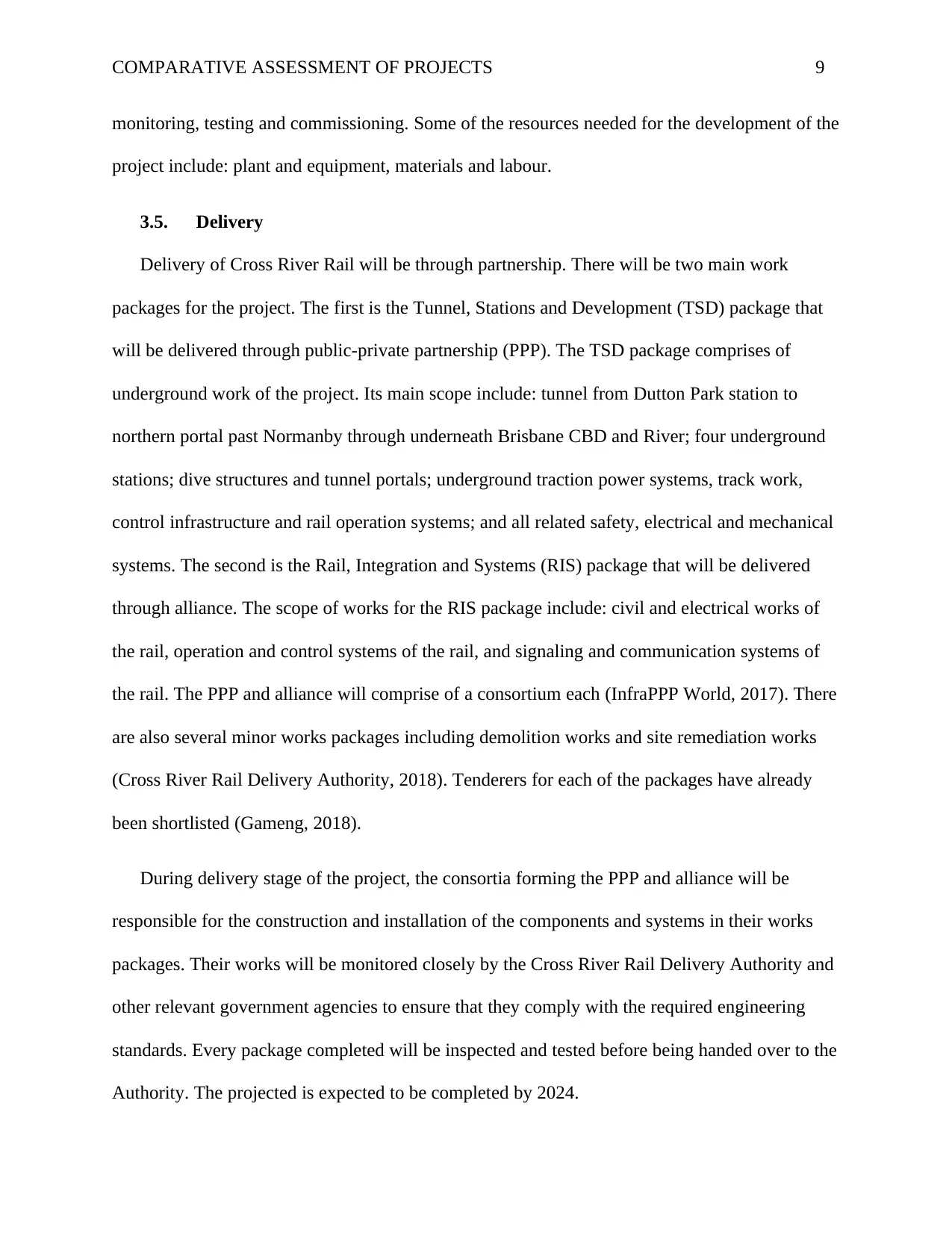
COMPARATIVE ASSESSMENT OF PROJECTS 9
monitoring, testing and commissioning. Some of the resources needed for the development of the
project include: plant and equipment, materials and labour.
3.5. Delivery
Delivery of Cross River Rail will be through partnership. There will be two main work
packages for the project. The first is the Tunnel, Stations and Development (TSD) package that
will be delivered through public-private partnership (PPP). The TSD package comprises of
underground work of the project. Its main scope include: tunnel from Dutton Park station to
northern portal past Normanby through underneath Brisbane CBD and River; four underground
stations; dive structures and tunnel portals; underground traction power systems, track work,
control infrastructure and rail operation systems; and all related safety, electrical and mechanical
systems. The second is the Rail, Integration and Systems (RIS) package that will be delivered
through alliance. The scope of works for the RIS package include: civil and electrical works of
the rail, operation and control systems of the rail, and signaling and communication systems of
the rail. The PPP and alliance will comprise of a consortium each (InfraPPP World, 2017). There
are also several minor works packages including demolition works and site remediation works
(Cross River Rail Delivery Authority, 2018). Tenderers for each of the packages have already
been shortlisted (Gameng, 2018).
During delivery stage of the project, the consortia forming the PPP and alliance will be
responsible for the construction and installation of the components and systems in their works
packages. Their works will be monitored closely by the Cross River Rail Delivery Authority and
other relevant government agencies to ensure that they comply with the required engineering
standards. Every package completed will be inspected and tested before being handed over to the
Authority. The projected is expected to be completed by 2024.
monitoring, testing and commissioning. Some of the resources needed for the development of the
project include: plant and equipment, materials and labour.
3.5. Delivery
Delivery of Cross River Rail will be through partnership. There will be two main work
packages for the project. The first is the Tunnel, Stations and Development (TSD) package that
will be delivered through public-private partnership (PPP). The TSD package comprises of
underground work of the project. Its main scope include: tunnel from Dutton Park station to
northern portal past Normanby through underneath Brisbane CBD and River; four underground
stations; dive structures and tunnel portals; underground traction power systems, track work,
control infrastructure and rail operation systems; and all related safety, electrical and mechanical
systems. The second is the Rail, Integration and Systems (RIS) package that will be delivered
through alliance. The scope of works for the RIS package include: civil and electrical works of
the rail, operation and control systems of the rail, and signaling and communication systems of
the rail. The PPP and alliance will comprise of a consortium each (InfraPPP World, 2017). There
are also several minor works packages including demolition works and site remediation works
(Cross River Rail Delivery Authority, 2018). Tenderers for each of the packages have already
been shortlisted (Gameng, 2018).
During delivery stage of the project, the consortia forming the PPP and alliance will be
responsible for the construction and installation of the components and systems in their works
packages. Their works will be monitored closely by the Cross River Rail Delivery Authority and
other relevant government agencies to ensure that they comply with the required engineering
standards. Every package completed will be inspected and tested before being handed over to the
Authority. The projected is expected to be completed by 2024.
⊘ This is a preview!⊘
Do you want full access?
Subscribe today to unlock all pages.

Trusted by 1+ million students worldwide

COMPARATIVE ASSESSMENT OF PROJECTS 10
3.6. Operation and Maintenance
The main operation activities that will be involved in the operation and maintenance of Cross
River Rail project include: ticketing, departure and arrival scheduling of the trains, traffic
control, control of signaling systems, service provision at the stations, customer care, repair and
periodic maintenance of the rail track, cleaning of various systems of the rail system, mechanical
maintenance of the system, electrical maintenance of the system, information system
maintenance, control system maintenance, lighting system maintenance, etc. Some of those who
will be involved in the operation and maintenance of the project include: Cross River Rail
Delivery Unit, BCC, Brisbane Metropolitan Traffic Management Centre, electrical engineers,
electrical engineering contractors, mechanical engineers, mechanical engineering contractors,
information and communication technology (ICT) engineers, ICT engineering contractors and
building services contractors, among others. These parties will ensure that the rail network
operates efficiently and is maintained properly to improve efficiency, safety, functionality and
durability. The main resources that are needed for the operation and maintenance of the project
are funding, labour and computer devices.
3.7. Retirement
Cross River Rail has been planned and designed for a 100-year horizon. This means that the
rail is expected to be operational for 100 years before it can be disposed, replaced or
retrofitted/improved. Nevertheless, the design life of different components of the rail is also
different. For example, the rail track has a design life of 100 years, the stations have a design life
of 50 years, the signaling and control systems have a design life of 30 years, and the cycling and
walking tracks have a design life of 50 years. It is very important to consider the retirement of
the project during planning and design of the project. This is because the retirement influences
3.6. Operation and Maintenance
The main operation activities that will be involved in the operation and maintenance of Cross
River Rail project include: ticketing, departure and arrival scheduling of the trains, traffic
control, control of signaling systems, service provision at the stations, customer care, repair and
periodic maintenance of the rail track, cleaning of various systems of the rail system, mechanical
maintenance of the system, electrical maintenance of the system, information system
maintenance, control system maintenance, lighting system maintenance, etc. Some of those who
will be involved in the operation and maintenance of the project include: Cross River Rail
Delivery Unit, BCC, Brisbane Metropolitan Traffic Management Centre, electrical engineers,
electrical engineering contractors, mechanical engineers, mechanical engineering contractors,
information and communication technology (ICT) engineers, ICT engineering contractors and
building services contractors, among others. These parties will ensure that the rail network
operates efficiently and is maintained properly to improve efficiency, safety, functionality and
durability. The main resources that are needed for the operation and maintenance of the project
are funding, labour and computer devices.
3.7. Retirement
Cross River Rail has been planned and designed for a 100-year horizon. This means that the
rail is expected to be operational for 100 years before it can be disposed, replaced or
retrofitted/improved. Nevertheless, the design life of different components of the rail is also
different. For example, the rail track has a design life of 100 years, the stations have a design life
of 50 years, the signaling and control systems have a design life of 30 years, and the cycling and
walking tracks have a design life of 50 years. It is very important to consider the retirement of
the project during planning and design of the project. This is because the retirement influences
Paraphrase This Document
Need a fresh take? Get an instant paraphrase of this document with our AI Paraphraser
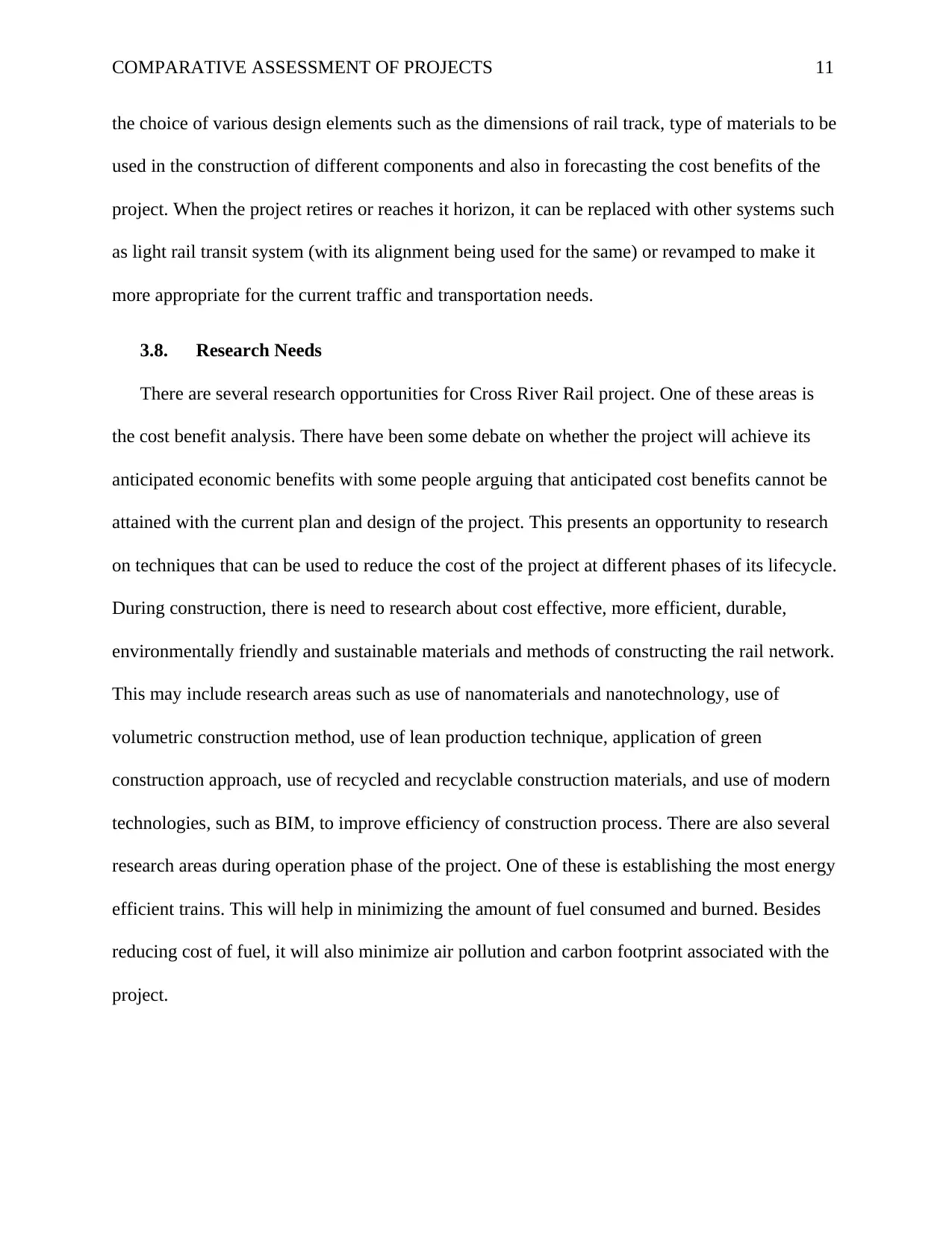
COMPARATIVE ASSESSMENT OF PROJECTS 11
the choice of various design elements such as the dimensions of rail track, type of materials to be
used in the construction of different components and also in forecasting the cost benefits of the
project. When the project retires or reaches it horizon, it can be replaced with other systems such
as light rail transit system (with its alignment being used for the same) or revamped to make it
more appropriate for the current traffic and transportation needs.
3.8. Research Needs
There are several research opportunities for Cross River Rail project. One of these areas is
the cost benefit analysis. There have been some debate on whether the project will achieve its
anticipated economic benefits with some people arguing that anticipated cost benefits cannot be
attained with the current plan and design of the project. This presents an opportunity to research
on techniques that can be used to reduce the cost of the project at different phases of its lifecycle.
During construction, there is need to research about cost effective, more efficient, durable,
environmentally friendly and sustainable materials and methods of constructing the rail network.
This may include research areas such as use of nanomaterials and nanotechnology, use of
volumetric construction method, use of lean production technique, application of green
construction approach, use of recycled and recyclable construction materials, and use of modern
technologies, such as BIM, to improve efficiency of construction process. There are also several
research areas during operation phase of the project. One of these is establishing the most energy
efficient trains. This will help in minimizing the amount of fuel consumed and burned. Besides
reducing cost of fuel, it will also minimize air pollution and carbon footprint associated with the
project.
the choice of various design elements such as the dimensions of rail track, type of materials to be
used in the construction of different components and also in forecasting the cost benefits of the
project. When the project retires or reaches it horizon, it can be replaced with other systems such
as light rail transit system (with its alignment being used for the same) or revamped to make it
more appropriate for the current traffic and transportation needs.
3.8. Research Needs
There are several research opportunities for Cross River Rail project. One of these areas is
the cost benefit analysis. There have been some debate on whether the project will achieve its
anticipated economic benefits with some people arguing that anticipated cost benefits cannot be
attained with the current plan and design of the project. This presents an opportunity to research
on techniques that can be used to reduce the cost of the project at different phases of its lifecycle.
During construction, there is need to research about cost effective, more efficient, durable,
environmentally friendly and sustainable materials and methods of constructing the rail network.
This may include research areas such as use of nanomaterials and nanotechnology, use of
volumetric construction method, use of lean production technique, application of green
construction approach, use of recycled and recyclable construction materials, and use of modern
technologies, such as BIM, to improve efficiency of construction process. There are also several
research areas during operation phase of the project. One of these is establishing the most energy
efficient trains. This will help in minimizing the amount of fuel consumed and burned. Besides
reducing cost of fuel, it will also minimize air pollution and carbon footprint associated with the
project.
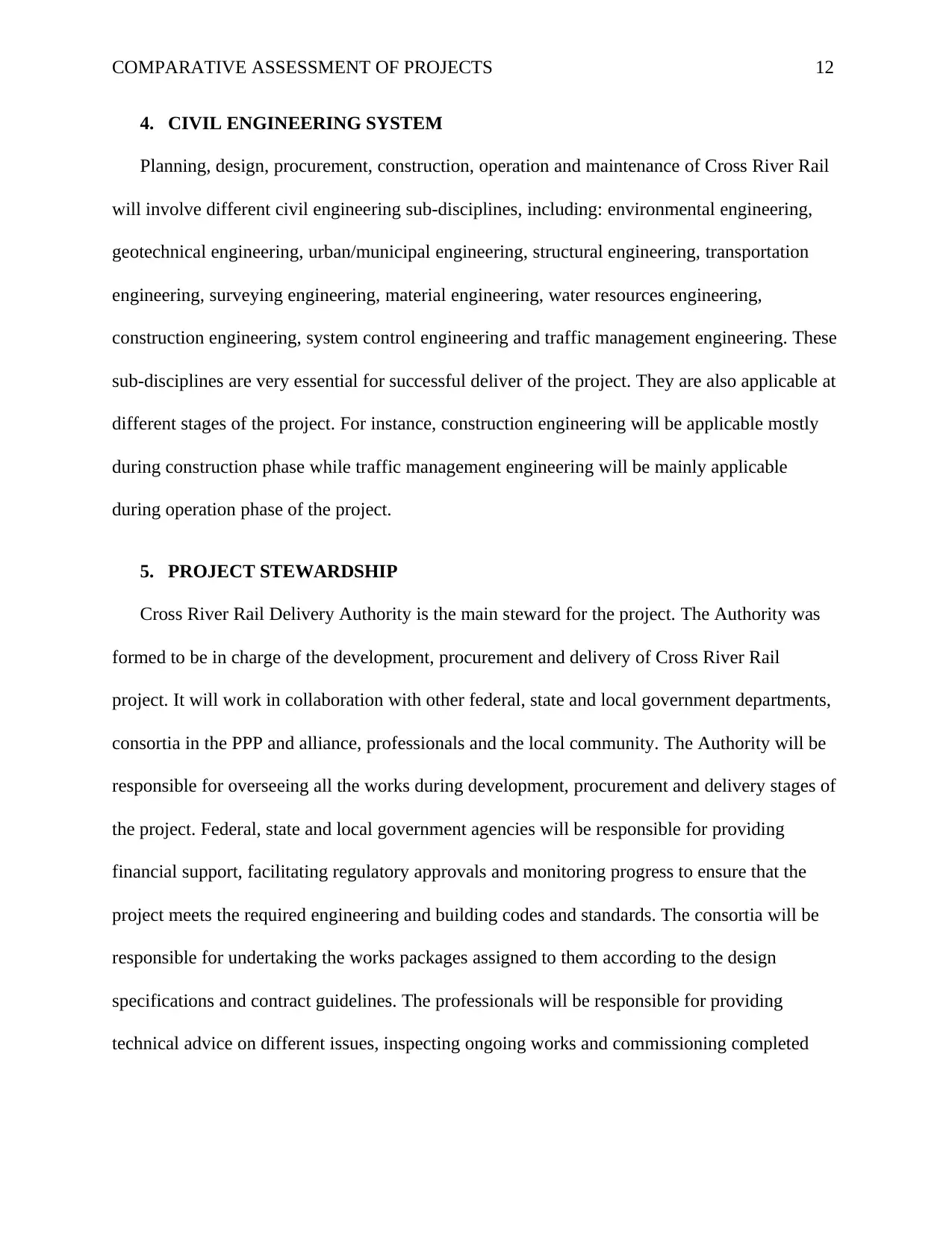
COMPARATIVE ASSESSMENT OF PROJECTS 12
4. CIVIL ENGINEERING SYSTEM
Planning, design, procurement, construction, operation and maintenance of Cross River Rail
will involve different civil engineering sub-disciplines, including: environmental engineering,
geotechnical engineering, urban/municipal engineering, structural engineering, transportation
engineering, surveying engineering, material engineering, water resources engineering,
construction engineering, system control engineering and traffic management engineering. These
sub-disciplines are very essential for successful deliver of the project. They are also applicable at
different stages of the project. For instance, construction engineering will be applicable mostly
during construction phase while traffic management engineering will be mainly applicable
during operation phase of the project.
5. PROJECT STEWARDSHIP
Cross River Rail Delivery Authority is the main steward for the project. The Authority was
formed to be in charge of the development, procurement and delivery of Cross River Rail
project. It will work in collaboration with other federal, state and local government departments,
consortia in the PPP and alliance, professionals and the local community. The Authority will be
responsible for overseeing all the works during development, procurement and delivery stages of
the project. Federal, state and local government agencies will be responsible for providing
financial support, facilitating regulatory approvals and monitoring progress to ensure that the
project meets the required engineering and building codes and standards. The consortia will be
responsible for undertaking the works packages assigned to them according to the design
specifications and contract guidelines. The professionals will be responsible for providing
technical advice on different issues, inspecting ongoing works and commissioning completed
4. CIVIL ENGINEERING SYSTEM
Planning, design, procurement, construction, operation and maintenance of Cross River Rail
will involve different civil engineering sub-disciplines, including: environmental engineering,
geotechnical engineering, urban/municipal engineering, structural engineering, transportation
engineering, surveying engineering, material engineering, water resources engineering,
construction engineering, system control engineering and traffic management engineering. These
sub-disciplines are very essential for successful deliver of the project. They are also applicable at
different stages of the project. For instance, construction engineering will be applicable mostly
during construction phase while traffic management engineering will be mainly applicable
during operation phase of the project.
5. PROJECT STEWARDSHIP
Cross River Rail Delivery Authority is the main steward for the project. The Authority was
formed to be in charge of the development, procurement and delivery of Cross River Rail
project. It will work in collaboration with other federal, state and local government departments,
consortia in the PPP and alliance, professionals and the local community. The Authority will be
responsible for overseeing all the works during development, procurement and delivery stages of
the project. Federal, state and local government agencies will be responsible for providing
financial support, facilitating regulatory approvals and monitoring progress to ensure that the
project meets the required engineering and building codes and standards. The consortia will be
responsible for undertaking the works packages assigned to them according to the design
specifications and contract guidelines. The professionals will be responsible for providing
technical advice on different issues, inspecting ongoing works and commissioning completed
⊘ This is a preview!⊘
Do you want full access?
Subscribe today to unlock all pages.

Trusted by 1+ million students worldwide
1 out of 25
Related Documents
Your All-in-One AI-Powered Toolkit for Academic Success.
+13062052269
info@desklib.com
Available 24*7 on WhatsApp / Email
![[object Object]](/_next/static/media/star-bottom.7253800d.svg)
Unlock your academic potential
Copyright © 2020–2025 A2Z Services. All Rights Reserved. Developed and managed by ZUCOL.





